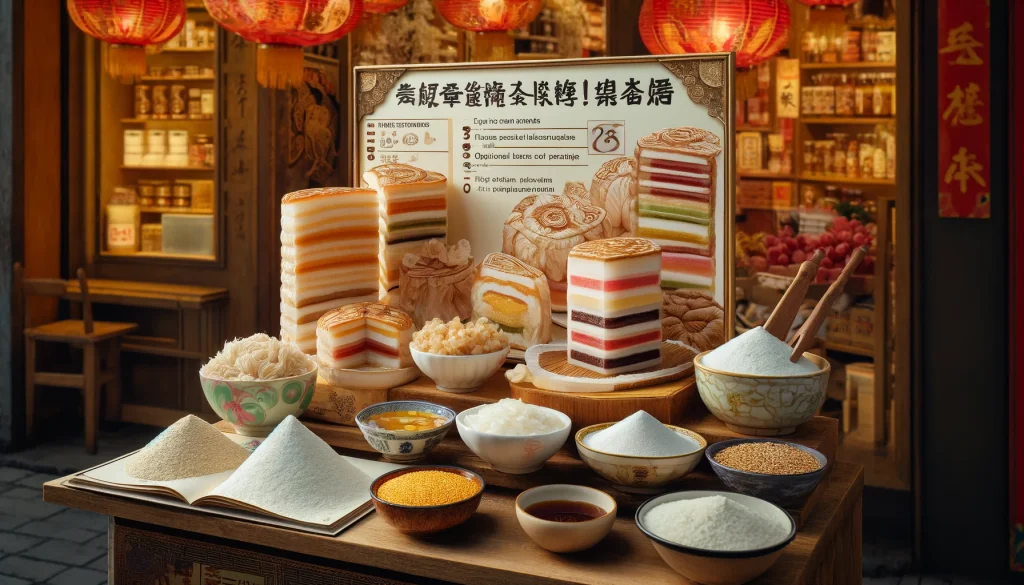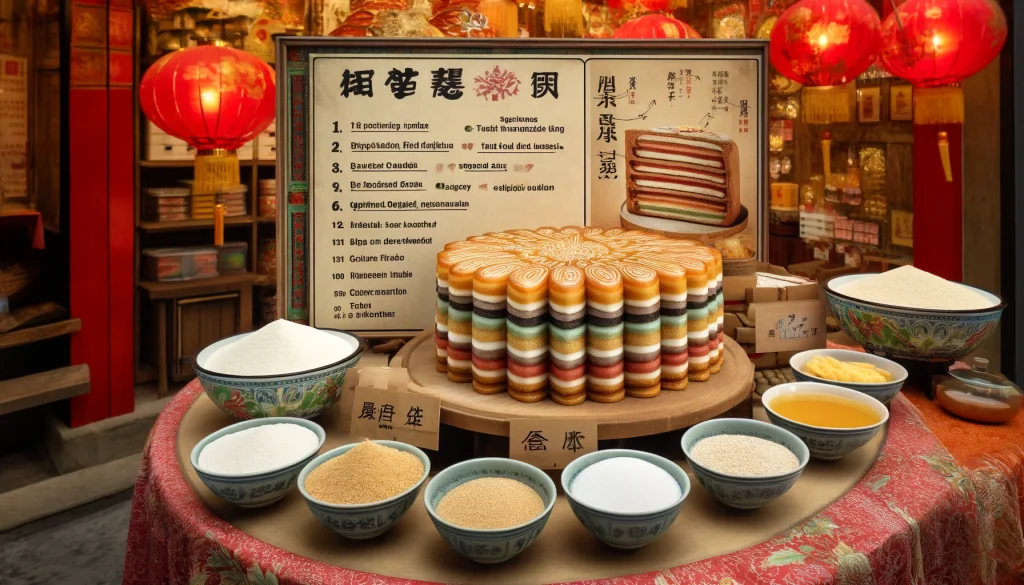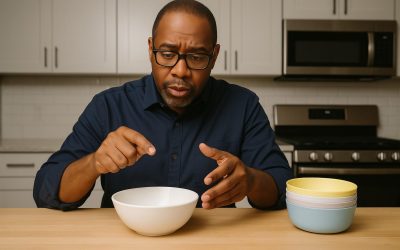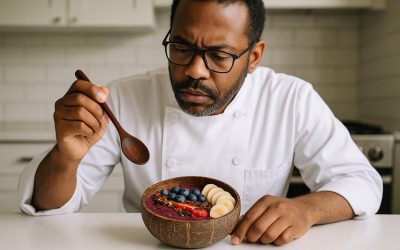As an Amazon Associate I earn from qualifying purchases.
Embarking on a journey through the rich tapestry of traditional Chinese desserts unveils a treasure trove of culinary delights, among which the Chinese Layered Rice Cake, or Qian Ceng Gao, shines brightly. This exquisite confection is a testament to the artistry and precision that defines Chinese cuisine, celebrated not only for its delicate, chewy texture and subtle sweetness but also for its visually striking appearance. Crafted from a harmonious blend of glutinous rice flour and rice flour, and often infused with natural colors to enhance its visual appeal, Qian Ceng Gao embodies the essence of festive celebrations and family gatherings.
Each layer of the cake is steamed meticulously, creating a multi-tiered masterpiece that captivates the senses with its soft, comforting bite and the gentle, sweet flavors that whisper tales of tradition and cultural heritage. The process of making Qian Ceng Gao is akin to painting with flavors, where each stroke adds depth and character to the final piece, resulting in a dessert that is as much a feast for the eyes as it is for the palate. In this exploration of the Chinese Layered Rice Cake recipe, we invite you on a culinary adventure that bridges the past with the present, offering a slice of Chinese culture that is both enriching and deliciously satisfying.
Chinese Layered Rice Cake Recipe

The Chinese Layered Rice Cake, known as “Qian Ceng Gao” (千层糕) or Thousand Layer Cake, is a traditional Chinese dessert celebrated for its intricate layers and subtle sweetness. This delicacy is often prepared during special occasions and festivals as a symbol of prosperity and happiness. The following recipe offers a step-by-step guide to creating this visually stunning and delicious treat at home.
Ingredients:
Batter:
- 400g glutinous rice flour
- 100g rice flour
- 150g sugar (adjust to taste)
- 800ml water
- 1/2 teaspoon salt
Coloring (optional):
- Food coloring or natural colorants (e.g., pandan juice for green, beetroot juice for red)
Instructions:
1. Prepare the Batter:
- In a large mixing bowl, combine the glutinous rice flour, rice flour, sugar, and salt. Gradually add water and whisk until the sugar is dissolved and the batter is smooth without lumps.
2. Divide and Color the Batter (optional):
- If you desire colored layers, divide the batter into separate bowls depending on how many colors you want. Add a few drops of food coloring or natural colorants to each and mix well to achieve your desired colors.
3. Prepare the Steaming Setup:
- Bring water to a boil in a steamer. Grease a square or rectangular steaming tray (preferably 8×8 inches or similar) with a neutral oil to prevent sticking.
4. Cook the Layers:
- Pour a thin layer of batter (about 1/4 cup or enough to cover the bottom of the tray) into the prepared tray. Place the tray in the steamer and cover. Steam each layer for about 5-7 minutes or until set and translucent.
- After each layer is cooked and slightly cooled (just a couple of minutes), pour another layer of batter on top. If using different colors, alternate them as you go to create the layered effect. Continue this process until all the batter is used, making sure the water in the steamer does not run out.
5. Final Steaming:
- Once the final layer is added, steam the entire cake for an additional 15-20 minutes to ensure it’s thoroughly cooked.
6. Cooling and Serving:
- Let the cake cool completely at room temperature before removing it from the tray. Once cooled, gently loosen the sides with a knife and carefully invert the cake onto a cutting board.
- Slice the cake into small, bite-sized pieces or diamonds for serving. The layers should be distinct and vibrant, showcasing the effort and care that went into its preparation.
Tips for Success:
- Consistent Layers: For evenly sized layers, use a measuring cup or ladle to ensure the same amount of batter is used for each layer.
- Prevent Condensation: To avoid water from the lid dripping onto the cake, wrap the lid of your steamer with a kitchen towel. This absorbs the steam and prevents it from affecting the cake’s texture.
- Smooth Layers: Between adding layers, gently tap the tray on the counter to remove any air bubbles, ensuring smooth, even layers.
The Chinese Layered Rice Cake not only offers a delightful treat but also represents the artistry and tradition of Chinese dessert making. Whether enjoying it during a festival, as part of a celebration, or simply as a special dessert, this cake is sure to impress with its beauty and subtle, satisfying sweetness.
Expert Tips
Creating the perfect Chinese Layered Rice Cake (Qian Ceng Gao) requires not just following a recipe but also understanding and mastering a few key techniques. Here are some expert tips to help you achieve the best results and truly impress with your Qian Ceng Gao:
1. Quality of Ingredients:
- Flour: Use high-quality glutinous rice flour and rice flour for the best texture. The proportion of these flours can significantly impact the cake’s texture, offering the right balance between chewiness and softness.
2. Batter Consistency:
- Smooth Batter: Ensure the batter is lump-free by sieving the mixed flour and whisking thoroughly after adding water. A smooth batter is crucial for creating even and delicate layers.
- Resting the Batter: Letting the batter rest for about 30 minutes before starting to steam allows the flour particles to fully absorb the water, leading to a more consistent texture.
3. Controlled Steaming:
- Even Heat: Make sure the water in the steamer is boiling before you start steaming the layers, and maintain a consistent medium-high heat to ensure even cooking.
- Steaming Time: Adjust the steaming time for each layer based on its thickness. Thin layers might need only 4-5 minutes, while thicker ones may require up to 7 minutes. Consistency is key.
- Avoid Opening the Lid Frequently: Keep the steamer lid closed as much as possible to maintain a consistent temperature and avoid temperature fluctuations that can affect the texture of the cake.
4. Layering Technique:
- Uniform Layers: Use a measuring cup or ladle to pour the batter for each layer to ensure they are of uniform thickness.
- Cooling Between Layers: Allow each layer to slightly cool and set (but not completely) before adding the next. This helps the layers adhere to each other without blending.
5. Preventing Moisture Accumulation:
- Wrap the Lid: Cover the steamer lid with a kitchen towel to absorb condensation and prevent water droplets from falling onto the cake, which could ruin the layers.
6. Adding Color:
- Natural vs. Artificial Colors: If you’re adding colors to your cake, consider using natural colorants like pandan juice, beetroot juice, or turmeric for vibrant yet natural hues. Add colorings sparingly to achieve the desired intensity without affecting the batter consistency.
7. Cutting and Serving:
- Cool Completely: Ensure the cake is completely cooled before attempting to cut it. This helps in achieving clean, beautiful layers without smudging.
- Sharp Knife: Use a sharp knife, lightly greased with oil, to cut the cake. Clean the knife after each cut to ensure smooth, clean slices.
8. Creative Flavors:
- Experiment with Flavors: Beyond traditional flavors, feel free to experiment by incorporating different extracts, zest, or purees into the batter to create unique flavor profiles.
By paying attention to these expert tips, you’ll not only refine your technique but also enhance the overall quality and presentation of your Chinese Layered Rice Cake. This meticulous attention to detail is what transforms a good dessert into an exceptional one, making your Qian Ceng Gao not just a treat for the palate but also a feast for the eyes.
Why This Recipe Is Just So Good…

The Chinese Layered Rice Cake (Qian Ceng Gao) captivates both the palate and the eyes, offering a unique culinary experience that makes it an exceptional dessert. Here are several reasons why this recipe stands out as especially delightful:
1. Visual Appeal:
- The intricate layers of Qian Ceng Gao, each meticulously steamed to perfection, create a visually stunning dessert. Whether you choose to incorporate colors or stick with the natural hue, the precise stratification is a feast for the eyes, making it not just a dessert but a work of art.
2. Textural Delight:
- The soft, chewy texture achieved through the combination of glutinous rice flour and rice flour is a key characteristic of this dessert. Each bite offers a slightly sticky yet pleasantly smooth mouthfeel, distinguishing it from other cake varieties and providing a unique eating experience.
3. Subtle Sweetness:
- Unlike many desserts that can be overwhelmingly sweet, the Chinese Layered Rice Cake boasts a subtle sweetness that allows the natural flavors of the ingredients to shine. This gentle approach to sugar makes it a perfect dessert for those who appreciate nuanced flavors without the intense sweetness.
4. Cultural Significance:
- Qian Ceng Gao holds a special place in Chinese culinary tradition, often prepared for festivals and celebrations as a symbol of prosperity and happiness. Enjoying this dessert connects individuals to a rich cultural heritage and the communal joy of sharing special occasions.
5. Versatility:
- This recipe’s versatility lies in its ability to incorporate various natural colorants and flavors, allowing for endless variations. From pandan to beetroot, the possibilities for customization are vast, enabling cooks to tailor the cake to specific tastes or themes.
6. Nutritional Balance:
- Made primarily from rice flour and with only a modest amount of sugar, the Chinese Layered Rice Cake is a relatively healthy option for those seeking a dessert that is not laden with fats and excessive sugars. Its ingredients lend themselves to a lighter, more balanced treat.
7. The Joy of Creation:
- The process of making Qian Ceng Gao, from preparing the batter to carefully steaming each layer, is both meditative and rewarding. It provides a sense of accomplishment and artistic expression, as each layer builds upon the last to create something truly special.
8. Universally Enjoyable:
- Finally, the universal appeal of this dessert, transcending age and cultural backgrounds, makes it a wonderful addition to any meal, celebration, or gathering. Its unique texture, appearance, and taste make it a hit among a wide audience, ensuring it’s always a welcomed treat.
The Chinese Layered Rice Cake is a testament to the beauty and complexity of traditional desserts, offering a harmonious blend of aesthetics, texture, and flavor that makes it irresistibly good. Its enduring popularity is a tribute to its delightful uniqueness and the joy it brings to those who make and savor it.
Storage Instructions
Storing Chinese Layered Rice Cake (Qian Ceng Gao) properly is essential to maintain its texture and flavor for later enjoyment. Here are some guidelines on how to store it:
Short-term Storage:
- Cool Down: Allow the cake to cool down completely to room temperature after steaming. This helps to prevent condensation from forming inside the storage container, which could make the layers soggy.
- Refrigerate: If you plan to consume the cake within a few days, it can be stored in the refrigerator. Place the cooled cake in an airtight container to keep it from drying out and to maintain its soft texture.
- Covering: If the cake is not in an airtight container, you can wrap it tightly in cling film or aluminum foil. However, an airtight container is recommended for the best preservation of moisture and texture.
Long-term Storage:
- Freezing: For longer storage, the cake can be frozen. Cut the cake into portions that are easy to thaw. Wrap each piece tightly in cling film or aluminum foil, then place them in a freezer bag or an airtight container. This method helps prevent freezer burn and keeps the cake fresh for up to 1 month.
- Thawing: To thaw the cake, transfer it from the freezer to the refrigerator and let it sit overnight. You can also thaw it at room temperature for a few hours if you plan to consume it the same day.
Reheating (if needed):
- Steaming: To restore the cake to its original texture, you can steam the pieces for a few minutes until they are warm and soft. This method works well for both refrigerated and thawed cakes.
- Microwave: Alternatively, you can microwave the cake on a microwave-safe plate, covered with a wet paper towel, for a few seconds to a minute, depending on the size of the piece. The wet paper towel helps to reintroduce moisture, preventing the cake from drying out.
Additional Tips:
- Avoid Direct Sunlight and Heat: Store the cake away from direct sunlight and heat sources to prevent spoilage.
- Consume Sooner Rather Than Later: While the cake can be stored, it’s best enjoyed fresh to appreciate its texture and layers fully. The longer it is stored, the more the quality may diminish.
Following these storage instructions will help ensure that your Chinese Layered Rice Cake remains delicious and retains its unique layered texture for as long as possible, allowing you to enjoy this traditional delicacy even days after making it.
Frequently Asked Questions (FAQ)

Q: What is Chinese Layered Rice Cake?
A: Chinese Layered Rice Cake, known as Qian Ceng Gao (千层糕), is a traditional Chinese dessert characterized by its multiple, distinct layers. It’s made primarily from glutinous rice flour and rice flour, offering a chewy, soft texture and subtle sweetness. This cake is often colored and flavored, making it not only delicious but also visually appealing.
Q: Can I make this cake without glutinous rice flour?
A: Glutinous rice flour is essential for achieving the chewy, sticky texture characteristic of Qian Ceng Gao. Substituting it with another type of flour will result in a different texture and may not produce the desired outcome. If you don’t have glutinous rice flour, it’s best to obtain it to ensure authenticity and quality of the final product.
Q: How can I add natural colors to the cake?
A: To add natural colors to the cake, you can use vegetable or fruit juices and natural food colorings. For example, pandan juice for green, beetroot juice for red, or turmeric powder for yellow. Mix these colorants into separate portions of the batter to achieve vibrant, natural colors without affecting the taste significantly.
Q: Why did my layers blend together?
A: Layers may blend together for several reasons, including pouring the next layer too soon before the previous one has set, not cooling each layer slightly before adding the next, or the batter being too thin. Ensure each layer sets for a few minutes and achieves a slightly firm surface before adding the next layer of batter.
Q: How do I store leftover Chinese Layered Rice Cake?
A: Leftover Chinese Layered Rice Cake should be stored in an airtight container in the refrigerator for up to 3-4 days. For longer storage, you can freeze it for up to 1 month. Wrap the cake or individual slices in plastic wrap before placing them in a freezer bag or container. Thaw in the refrigerator or at room temperature before serving.
Q: Can I steam the cake in a microwave instead of a traditional steamer?
A: While traditional steaming is recommended for the best texture, you can use a microwave steaming method as an alternative. However, results may vary, and it’s challenging to achieve the same consistency and layered effect. If using a microwave, do so with caution and adjust the cooking time based on your microwave’s power settings.
Q: How do I ensure my cake is soft and chewy, not hard?
A: To ensure a soft and chewy texture, make sure to use the correct ratio of glutinous rice flour to rice flour, mix the batter until smooth, and steam each layer adequately. Overcooking or incorrect flour ratios can lead to a harder texture. Also, keeping the cake covered while it cools can help retain moisture, contributing to a softer texture.
Q: Is it possible to make this cake vegan?
A: Yes, the Chinese Layered Rice Cake is naturally vegan, as it mainly consists of rice flours, water, and sugar. Just ensure that any added colorants or flavors are also vegan. This makes it a suitable dessert for those following a vegan lifestyle.
Q: How many layers should the cake have?
A: The number of layers in a Qian Ceng Gao can vary depending on your preference and the size of your steaming tray. Traditionally, the cake boasts many thin layers, sometimes up to 9 or more, to create a visually striking effect. The key is to ensure each layer is thin and even.
Q: Can I flavor the cake with something other than sugar?
A: Absolutely! While sugar provides the basic sweetness, you can enhance your cake with various flavors. Common additions include coconut milk for a richer taste, vanilla extract for aroma, or even incorporating pureed fruits or matcha powder into the batter for flavor and color. Experiment to find the combinations that suit your taste best.
Q: How can I ensure the layers in my Chinese Layered Rice Cake are distinct and don’t blend together?
A: To ensure distinct layers in your Chinese Layered Rice Cake, follow these steps:
Consistent Batter Consistency: Make sure the batter is smooth and of uniform consistency before dividing it for layering. This helps each layer set properly without blending into the next.
Cool Each Layer: Allow each steamed layer to cool slightly and set (about 2-3 minutes) before adding the next layer of batter. This prevents the layers from blending.
Even Pouring: Pour the batter gently and evenly over the set layer to avoid disturbing it. Using a ladle or measuring cup can help control the pour.
Q: Can I make this cake without a steamer?
A: Yes, it’s possible to make the Chinese Layered Rice Cake without a traditional steamer by using a makeshift steaming setup:
Use a Large Pot: Fill a large pot with a couple of inches of water, and place a heatproof stand or rack in it to hold the cake pan above the water level.
Cover Tightly: Use a tight-fitting lid or aluminum foil to cover the pot, ensuring that steam does not escape. If using a lid, you might want to wrap it in a kitchen towel to prevent condensation from dripping onto the cake.
Q: How do I add natural colors to the cake without altering the texture?
A: To add natural colors without altering the texture:
Use Concentrated Colorants: Natural colorants (like pandan juice, beetroot juice, or turmeric powder mixed with a little water) should be used in concentrated forms to avoid adding too much liquid to the batter.
Adjust the Batter: If you find the batter too thin after adding your colorants, you can slightly increase the amount of rice flour to achieve the desired consistency.
Q: My cake turned out too dense. What could have gone wrong?
A: If your cake is too dense, consider these potential issues:
Overmixing the Batter: Overmixing can lead to a denser texture as it develops the gluten in the flour. Mix just until the ingredients are combined.
Incorrect Flour Ratio: Ensure you’re using the correct ratio of glutinous rice flour to regular rice flour, as too much of either can affect the cake’s texture.
Steaming Time: Understeaming each layer could result in them not setting correctly, leading to a denser overall texture. Make sure each layer is fully set before adding the next.
Q: How can I make the cake sweeter or incorporate different flavors?
A: To adjust sweetness or add flavors:
Adjust Sugar: Simply increase the sugar in the batter for a sweeter cake. Do this gradually to avoid oversweetening.
Flavor Extracts: Incorporate flavor extracts (like vanilla, almond, or coconut) into the batter. Add these sparingly to not overpower the subtle flavors of the cake.
Layer Fillings: Consider adding thin layers of sweetened red bean paste, custard, or coconut between some rice cake layers for additional sweetness and flavor complexity.
Q: How long can I store the Chinese Layered Rice Cake, and how should it be stored?
A: The cake can be stored in an airtight container in the refrigerator for up to 3-4 days or frozen for up to 1 month. For refrigeration, let the cake cool completely before storing to prevent condensation. For freezing, wrap individual slices in plastic wrap before placing them in an airtight container. Thaw in the refrigerator overnight or at room temperature for a few hours before serving.
Q: Can I use something other than rice flour if I don’t have it?
A: Chinese Layered Rice Cake traditionally relies on the unique properties of rice flour for its texture. Substituting with other types of flour may significantly alter the outcome. If you must substitute, a mixture of cornstarch and all-purpose flour might mimic the texture to some extent but with varying results. It’s best to use the specified flours for authentic texture and flavor.
Conclusion
In crafting the Chinese Layered Rice Cake, or Qian Ceng Gao, we delve into a tradition that transcends mere culinary practice, stepping into a realm where each layer represents a meticulous art form, a celebration of heritage, and a testament to the patience and skill of the cook. This dessert, with its delicate layers, each as thin and refined as the next, is not just a treat for the taste buds but a visual spectacle that embodies the beauty and depth of Chinese culinary traditions.
As we conclude our exploration of this exquisite recipe, it’s clear that the Chinese Layered Rice Cake is more than just a dessert. It is a symbol of prosperity, a centerpiece for celebrations, and a bridge connecting generations. The process of making it, layer by painstaking layer, is a meditation on the importance of precision, patience, and the joy found in sharing something truly beautiful with loved ones.
Whether infused with vibrant natural colors or flavored with subtle enhancements, each variation of Qian Ceng Gao carries with it the whispers of centuries-old traditions, inviting those who partake to savor not just the flavors but the stories woven into its creation. In this way, the Chinese Layered Rice Cake stands as a beacon of cultural pride, showcasing the elegance and richness of Chinese desserts. It serves as a reminder that sometimes, the simplest ingredients, when brought together with care and respect, can create something truly extraordinary, bridging past and present, and delighting those who have the pleasure of experiencing its unique charm.






